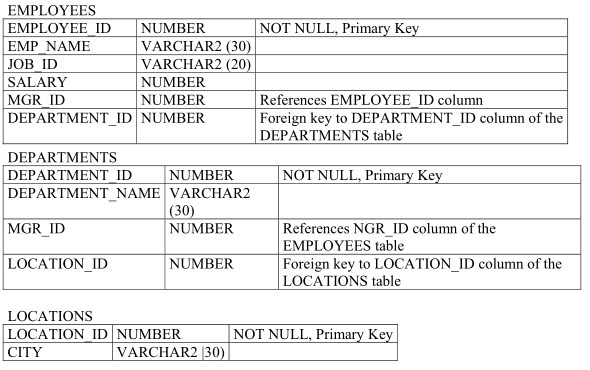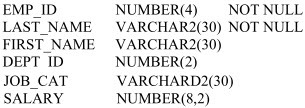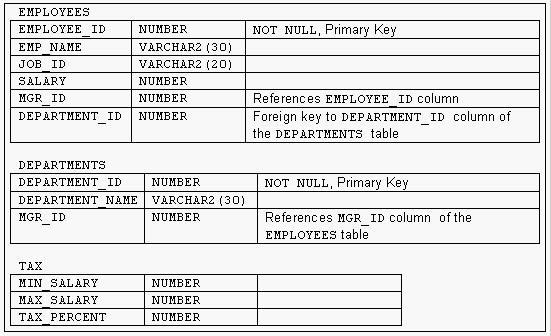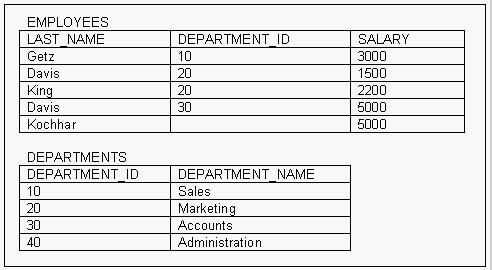Examine the structure of the EMPLOYEES, DEPARTMENTS, and TAX tables. EMPLOYEES NOT NULL, Primary EMPLOYEE_ID NUMBER Key VARCHAR2 EMP_NAME (30) VARCHAR2 JOB_ID (20) SALARY NUMBER References MGR_ID NUMBER EMPLOYEE_ID column DEPARTMENT_ID NUMBER Foreign key to DEPARTMENT_ID column of the DEPARTMENTS table DEPARTMENTS NOT NULL, DEPARTMENT_ID NUMBER Primary Key VARCHAR2 DEPARTMENT_NAME |30| References MGR_ID column MGR_ID NUMBER of the EMPLOYEES table TAX MIN_SALARY NUMBER MAX_SALARY NUMBER TAX_PERCENT NUMBER For which situation would you use a nonequijoin query?()
 Which two SQL statements produce the name, department name, and the city of all the employees who earn more then 10000?()
Which two SQL statements produce the name, department name, and the city of all the employees who earn more then 10000?()
 Which two SQL statements produce the name, department name, and the city of all the employees who earn more then 10000?()
Which two SQL statements produce the name, department name, and the city of all the employees who earn more then 10000?()
Examine the structure of the STUDENTS table:

You need to create a report of the 10 students who achieved the highest ranking in the course INT SQL and who completed the course in the year 1999.Which SQL statement accomplishes this task?()

Examine the structure of the EMP_DEPT_VU view:
Column Name Type Remarks
EMPLOYEE_ID NUMBER From the EMPLOYEES table
EMP_NAME VARCHAR2(30) From the EMPLOYEES table JOB_ID VARCHAR2(20) From the EMPLOYEES table
SALARY NUMBER From the EMPLOYEES table
DEPARTMENT_ID NUMBER From the DEPARTMENTS table DEPT_NAME VARCHAR2(30) From the DEPARTMENTS table Which SQL statement produces an error?()
Examine the description of the EMPLOYEES table:
EMP_ID NUMBER(4) NOT NULL
LAST_NAME VARCHAR2(30) NOT NULL
FIRST_NAME VARCHAR2(30)
DEPT_ID NUMBER(2)
Which statement produces the number of different departments that have employees with last name Smith? ()
Examine the description of the EMPLOYEES table:
EMP_ID NUMBER(4) NOT NULL
LAST_NAME VARCHAR2(30) NOT NULL
FIRST_NAME VARCHAR2(30)
DEPT_ID NUMBER(2)
Which statement produces the number of different departments that have employees with last name Smith?()
Examine the structure of the EMPLOYEES table:
EMPLOYEE_ID NUMBER NOT NULL, Primary Key
EMP_NAME VARCHAR2(30)
JOB_ID NUMBER\
SAL NUMBER
MGR_ID NUMBER References EMPLOYEE_ID column
DEPARTMENT_ID NUMBER Foreign key to DEPARTMENT_ID column of the DEPARTMENTS table You created a sequence called EMP_ID_SEQ in
orderto populate sequential values for the EMPLOYEE_ID column of the EMPLOYEES table. Which two statements regarding the EMP_ID_SEQ sequence are true? ()
Examine the description of the EMPLOYEES table:

Which statement shows the maximum salary paid in each job category of each department?()
Click the Exhibit button to examine the structures of the EMPLOYEES, DEPARTMENTS, and TAX tables.
For which situation would you use a nonequijoin query?()
Examine the structure of the EMPLOYEES, DEPARTMENTS, and LOCATIONS tables.

Which two SQL statements produce the name, department name, and the city of all the employees who earn more then 10000?()
Examine the data of the EMPLOYEES table.
EMPLOYEES (EMPLOYEE_ID is the primary key. MGR_ID is the ID of managers and refers to the EMPLOYEE_ID)

Which statement lists the ID, name, and salary of the employee, and the ID and name of the employee's manager, for all the employees who have a manager and earn more than 4000?()
Observe the structure of the table employees:

The table contains 8475 records.
One of the employees wants to know the names of all employees of the company. For this, he fires the following query:
SELECT * FROM EMPLOYEES ORDER BY emp_fname;
Since the operation performed on executing the query cannot fit into memory, it requires disk space to complete the operation.
Which of the following types of segments will Oracle allocate to complete the operation and to provide the required result?()
Click the Exhibit button and examine the data in the EMPLOYEES and DEPARTMENTS tables.
You want to retrieve all employees, whether or not they have matching departments in the departments table. Which query would you use?()
Examine the structure of the EMPLOYEES and NEW_EMPLOYEES tables: EMPLOYEES
EMPLOYEE_ID NUMBER Primary Key
FIRST_NAME VARCHAR2 (25)
LAST_NAME VARCHAR2 (25)
HIRE_DATE DATE
NEW EMPLOYEES
EMPLOYEE_ID NUMBER Primary Key
NAME VARCHAR2 (60)
Which DELETE statement is valid? ()
Examine the structure of the EMPLOYEES and NEW_EMPLOYEES tables:
EMPLOYEES
EMPLOYEE_ID NUMBER Primary Key
FIRST_NAME VARCHAR2(25)
LAST_NAME VARCHAR2(25)
HIRE_DATE DATE
NEW_EMPLOYEES
EMPLOYEE_ID NUMBER Primary Key
NAME VARCHAR2 (60)
Which DELETE statement is valid?()
Examine the structure of the EMPLOYEES and NEW_EMPLOYEES tables:
EMPLOYEES
EMPLOYEE_ID NUMBER Primary Key
FIRST_NAME VARCHAR2(25)
LAST_NAME VARCHAR2(25)
HIRE_DATE DATE
NEW_EMPLOYEES
EMPLOYEE_ID NUMBER Primary Key
NAME VARCHAR2(60)
Which UPDATE statement is valid?()
免费的网站请分享给朋友吧